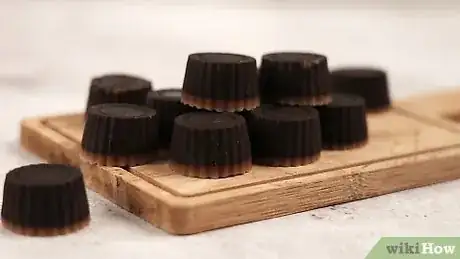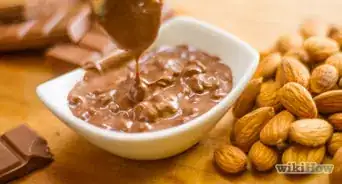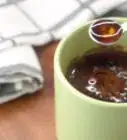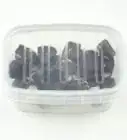This article was co-authored by wikiHow staff writer, Kyle Hall. Kyle Hall works on the content team at wikiHow. He helps manage our team of editors and creates content for a variety of wikiHow projects. Kyle continually looks for new ways to improve the content at wikiHow and make it more helpful and enjoyable for readers. He graduated from Eckerd College in 2015, where he majored in Political Science.
There are 14 references cited in this article, which can be found at the bottom of the page.
wikiHow marks an article as reader-approved once it receives enough positive feedback. This article received 42 testimonials and 100% of readers who voted found it helpful, earning it our reader-approved status.
This article has been viewed 4,814,525 times.
Learn more...
If you’ve got chocolate on your mind (who doesn’t?), why not skip the trip to the store and make your own at home instead? That’s right—you can easily make your own smooth, creamy chocolate in the comfort of your kitchen using just a few simple ingredients. Whether you’re craving classic milk chocolate or some luscious dark chocolate, we’ve got you covered with 2 easy recipes below. Let’s get mixing!
Things You Should Know
- All you need to make chocolate is cocoa butter, cocoa powder, milk powder, and confectioners' sugar.
- Combine all of your ingredients in a makeshift double boiler until everything is melted together and smooth and creamy.
- Pour your chocolate into a candy mold or onto a nonstick surface and harden it in the fridge for 1 hour.
Ingredients
- ¾ cup (140 g) of cocoa butter
- ¾ cup (80 g) of cocoa powder
- ¼ cup (30 g) of milk powder, soy milk powder, almond milk powder, or rice milk powder
- 1 cup (100 g) of confectioners' sugar, 1 cup (240 mL) of agave syrup, or 1–2 teaspoons (4.9–9.9 mL) of liquid stevia
- Salt (optional—to taste)
Makes 12 oz (340 g) of chocolate
- 1/2 cup (50 g) of cocoa powder
- 1⁄2 cup (120 mL) of coconut oil
- 4 tablespoons (59 mL) of honey
- 1⁄2 tablespoon (7.4 mL) of vanilla extract
- ¼ cup (25 g) of confectioners' sugar, 1⁄4 cup (59 mL) of agave syrup, or 3-6 drops of liquid stevia (optional)
Makes 10 oz (283 g) of chocolate
Steps
Milk Chocolate
-
1Make a double boiler using a pot of water and a mixing bowl. Fill a pot halfway with water and place it on the stovetop over medium heat. Then, set a small, heat-safe mixing bowl over the opening of the pot. The water will heat the bowl from underneath so you can melt your ingredients in the bowl without burning them.[1]
- The water should be hot, but not boiling. If it’s boiling, it might scorch your chocolate as it cooks!
- Think you’ll make your own chocolate regularly? Consider investing in a real double boiler so you don’t have to make one every time.
-
2Melt ¾ cup (140 g) of cocoa butter in the heated mixing bowl. Keep the cocoa butter moving continuously at the bottom of the bowl so it melts faster. Cocoa butter melts at about the same speed as ordinary butter, and it looks pretty similar when it melts too.[2]
- Find cocoa butter in the baking aisle at any health food store, as well as some major supermarkets.
- An equal amount of coconut oil works great as a substitute for cocoa butter.[3]
Advertisement -
3Sift ¾ cup (80 g) of cocoa powder into the melted cocoa butter. Add the cocoa powder little by little using a sieve to break up any clumping. Use a whisk or metal spoon to stir the two ingredients together until the cocoa powder dissolves completely. Make sure there aren’t any clumps or dry pockets in the mixture.[4]
-
4Shake in ¼ cup of milk powder and 1 cup (100 g) of confectioners' sugar. Give the mixture another thorough stir to make sure the last of your dry ingredients are fully incorporated. The chocolate should be starting to take on a lighter, more delicate color after adding the milk powder.[5]
- Want to make vegan “milk” chocolate? Just use an equal amount of soy milk powder, almond milk powder, or rice milk powder instead.[6]
- If you’re trying to cut back on sugar, use 1 cup (240 mL) of agave syrup or 1–2 teaspoons (4.9–9.9 mL) of liquid stevia instead of confectioners' sugar.
- You might think you should use regular milk to make milk chocolate, but milk is actually too liquidy! All that excess liquid would leave your chocolate runny and prevent it from setting.[7]
Tip: A small pinch of salt can offset the sweetness of the sugar and give your chocolate a more complex flavor.
-
5Remove the bowl from the heat and stir the chocolate until it thickens. Fold the chocolate over on itself repeatedly from the bottom of the bowl until it’s smooth, creamy, and free of lumps.[8]
- Your chocolate will still be somewhat thin at this point. Don’t worry—it will continue to thicken as it sets up.
- For even more deliciousness, mix in nuts, mint, or dried fruit.
Tip: Soak raisins in rum for an hour and use them as a flavoring agent.
-
6Pour the chocolate onto a nonstick surface or into a candy mold. If you want your chocolate to harden into a single large sheet, spread it out over a nonstick baking mat or sheet of parchment paper to a thickness of about 1⁄2 inch (1.3 cm) edge-to-edge. To make individual chocolates, transfer the warm chocolate to a candy mold instead.[9]
- No candy mold? Use a well-greased ice cube tray!
- If you’re using a mold, tap the bottom onto a hard surface a few times to get rid of any bubbles in the chocolate.[10]
-
7Let your chocolate harden in the refrigerator for 1 hour. Once your chocolate sets up, break it into pieces or pop individual chocolates out of their molds and dig in!
- Store your homemade milk chocolate in a covered container on your countertop, or inside a pantry or another cool, dry place. It should keep for up to 1 year.[11]
Dark Chocolate
-
1Melt 1⁄2 cup (120 mL) of coconut oil in a small pot over low heat. Coconut oil has a low melting point, so this should only take a few seconds. Keep the coconut oil moving continuously at the bottom of the pot to help it melt faster.[12]
Tip: If possible, use stainless steel cookware to prepare your homemade chocolate (or another type of nonstick cookware that’s safe to soak). Otherwise, cleanup can be quite a hassle.
-
2Add 4 tablespoons (59 mL) of honey and 1⁄2 tablespoon (7.4 mL) of vanilla extract. Use a whisk or metal spoon to scrape the sticky honey into the pot. Then, drizzle in the vanilla. Stir the ingredients into the melted oil until they dissolve and form a thin, syrupy mixture.[13]
- Be sure to keep your cooktop on a low heat setting. If the oil gets too hot, it could scorch the sugars in the honey and spoil the flavor of the finished chocolate.
- For sweeter dark chocolate, add 1/4 cup (25 g) of confectioners' sugar, 1⁄4 cup (59 mL) of agave syrup, or 3-6 drops of liquid stevia at the same time that you add the honey and vanilla.
-
3Sift in 1/2 cup (50 g) of cocoa powder gradually. Rather than dumping all of the cocoa powder in at once, add it a little at a time using a sieve over the pot to break up any clumps. As you do, keep your whisk or spoon moving to help distribute the cocoa powder evenly throughout the mixture.[14]
-
4Take the chocolate off the heat and continue stirring it as it thickens. You’ll know your chocolate is done when it takes on a smooth, dark color and the surface becomes slightly glossy. At this point, it just needs to be left to harden![15]
-
5Transfer the warm chocolate to a nonstick surface or candy mold to cool. Carefully pour the chocolate out of the pot and onto a flexible nonstick baking mat or cookie sheet lined with parchment paper. Use a spatula to spread the chocolate about 1⁄2 inch (1.3 cm) thick. For cute, bite-sized pieces of chocolate, pour your chocolate into a candy mold instead.[16]
-
6Refrigerate your chocolate for 1 hour. Once it’s fully set, it’s ready to break into pieces or remove from the mold. Enjoy![17]
- Store your finished chocolate in the refrigerator, or keep it in a covered container on your countertop. Dark chocolate will last for up to 2 years.[18]
- If your chocolate begins to melt or soften at room temperature, place it back in the refrigerator at any point to harden it back up.
Community Q&A
-
QuestionWhat does it mean when chocolate "seizes"?
 wikiHow Staff EditorThis answer was written by one of our trained team of researchers who validated it for accuracy and comprehensiveness.
wikiHow Staff EditorThis answer was written by one of our trained team of researchers who validated it for accuracy and comprehensiveness.
Staff Answer wikiHow Staff EditorStaff AnswerWhen chocolate seizes, the sugars and fat separate. This can happen if you overheat the chocolate or add cold ingredients or any liquids to the mixture as you're making your chocolate. If your chocolate has seized, try adding more cocoa butter.
wikiHow Staff EditorStaff AnswerWhen chocolate seizes, the sugars and fat separate. This can happen if you overheat the chocolate or add cold ingredients or any liquids to the mixture as you're making your chocolate. If your chocolate has seized, try adding more cocoa butter. -
QuestionCan't we melt the butter in the microwave?
 wikiHow Staff EditorThis answer was written by one of our trained team of researchers who validated it for accuracy and comprehensiveness.
wikiHow Staff EditorThis answer was written by one of our trained team of researchers who validated it for accuracy and comprehensiveness.
Staff Answer wikiHow Staff EditorStaff AnswerYes, you can! Microwave the cocoa butter for 20-30 seconds to melt it. If it still hasn't melted, keep microwaving it in 10-second intervals.
wikiHow Staff EditorStaff AnswerYes, you can! Microwave the cocoa butter for 20-30 seconds to melt it. If it still hasn't melted, keep microwaving it in 10-second intervals. -
QuestionDo I need to add vanilla to chocolate to help the flavor?
 wikiHow Staff EditorThis answer was written by one of our trained team of researchers who validated it for accuracy and comprehensiveness.
wikiHow Staff EditorThis answer was written by one of our trained team of researchers who validated it for accuracy and comprehensiveness.
Staff Answer wikiHow Staff EditorStaff AnswerAlthough this is often added as part of the process of making chocolate commercially, you don't need to add it when making chocolate at home. If you do want to add vanilla as a flavoring, don't use vanilla extract as the liquid will cause the chocolate to seize. Instead, use powdered form instead.
wikiHow Staff EditorStaff AnswerAlthough this is often added as part of the process of making chocolate commercially, you don't need to add it when making chocolate at home. If you do want to add vanilla as a flavoring, don't use vanilla extract as the liquid will cause the chocolate to seize. Instead, use powdered form instead.
Things You'll Need
- Small pot (and a heat-safe mixing bowl if you're making milk chocolate)
- Whisk or metal spoon
- Sieve
- Flexible nonstick baking mat or a decorative candy mold
- Spatula
References
- ↑ https://bakingbites.com/2009/09/how-to-make-a-double-boiler/
- ↑ https://www.youtube.com/watch?v=R5wt7-NO4AM&t=48s
- ↑ https://poormansgourmetkitchen.com/homemade-milk-chocolate.html
- ↑ https://hebbarskitchen.com/homemade-chocolate-recipe-milk-chocolate/
- ↑ https://www.youtube.com/watch?v=R5wt7-NO4AM&t=86s
- ↑ https://www.myfrugalhome.com/powdered-milk-substitute-non-fat-dry-milk/
- ↑ https://damecacao.com/chocolate-making-milk-powder/
- ↑ https://www.namscorner.com/homemade-milk-chocolate-how-to-make-chocolate-in-home/
- ↑ https://www.youtube.com/watch?v=R5wt7-NO4AM&t=139s
- ↑ https://hebbarskitchen.com/homemade-chocolate-recipe-milk-chocolate/
- ↑ https://sweets.seriouseats.com/2011/08/best-way-to-store-chocolate-how-to-store-bonbons.html
- ↑ https://thecoconutmama.com/coconut-oil-chocolate-bars/
- ↑ https://www.allrecipes.com/recipe/236212/homemade-melt-in-your-mouth-dark-chocolate-paleo/
- ↑ https://www.allrecipes.com/recipe/236212/homemade-melt-in-your-mouth-dark-chocolate-paleo/
- ↑ https://www.youtube.com/watch?v=YkVi_1GflZc&t=152s
- ↑ https://www.precisionnutrition.com/chocolate-making
- ↑ https://www.allrecipes.com/recipe/236212/homemade-melt-in-your-mouth-dark-chocolate-paleo/
- ↑ https://sweets.seriouseats.com/2011/08/best-way-to-store-chocolate-how-to-store-bonbons.html
About This Article
To make chocolate, first melt ½ cup (110 g) of coconut oil in a saucepan over low heat. Then, add ½ cup (65 g) of cocoa powder and 2 tablespoons (42 g) of honey to the saucepan and mix everything together for 2 minutes. Next, turn the heat off and mix in ½ teaspoon (2 g) of vanilla extract. Add a pinch of cinnamon, cardamom, or salt if you’d like to give your chocolate some spice. Then, stir everything together for 1 more minute. Finally, pour the chocolate into muffin-tin liners or silicone molds and store it in the refrigerator until it turns solid. To learn how to make easy dark chocolate with just 4 ingredients, read on!


























































